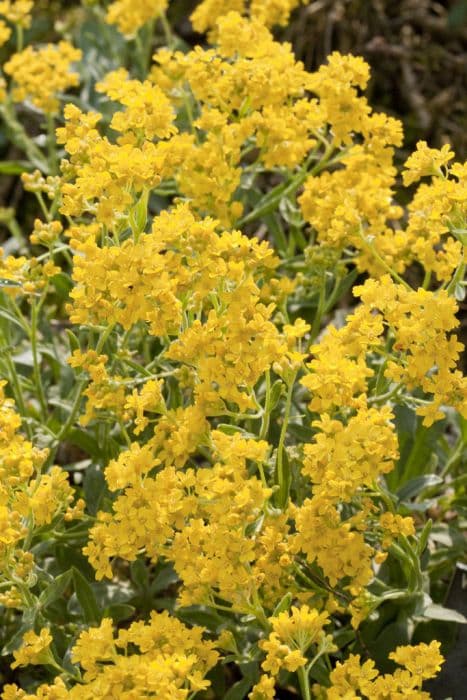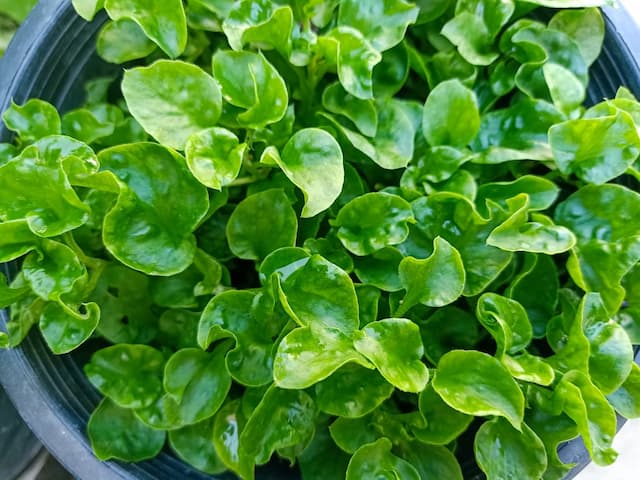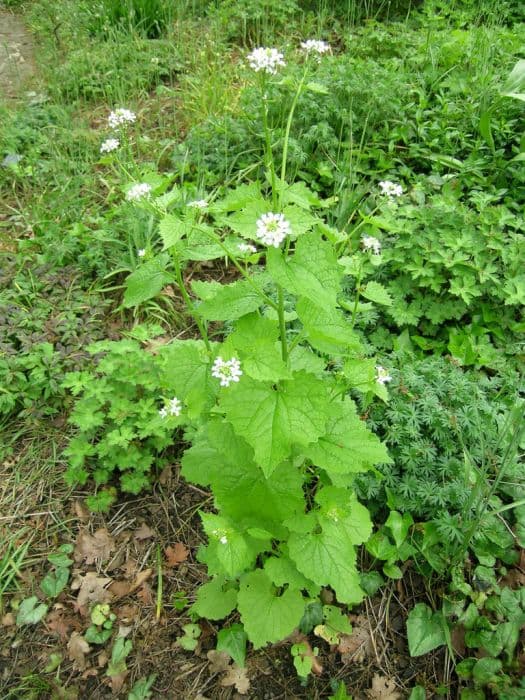Basket of Gold Aurinia saxatilis

ABOUT
Aurinia saxatilis, commonly known as basket-of-gold, is a perennial plant characterized by its vibrant display. It features a dense clump of grey-green foliage, from which emerges a profusion of tiny, bright yellow flowers. The leaves are small, oblong, and covered with fine hairs, giving them a silvery appearance. The flowers, which are remarkably brilliant, are grouped in clusters above the foliage, creating a dramatic contrast. As the plant comes into full bloom, it can appear as though it's a mound of gold, owing to the sheer coverage of its golden blossoms. The appearance of basket-of-gold is notably eye-catching during its peak flowering period, as it becomes a sea of yellow that draws in the eye and provides a warm, cheerful aspect to gardens and landscapes.
About this plant
 Names
NamesFamily
Brassicaceae
Synonyms
Basket of Gold, Gold Dust, Golden Alyssum, Rock Madwort
Common names
Alyssum saxatile, Aurinia saxatilis subsp. saxatilis, Alyssum saxatile var. compactum, Alyssum orientale, Alyssum saxatile var. orientale, Alyssum saxatile var. psilocarpum, Crucifera saxatilis, Aethionema saxatile.
 Toxicity
ToxicityTo humans
Basket of Gold generally does not contain toxins that are harmful to humans. However, as with any plant, individual allergies or sensitivities can lead to adverse reactions. If ingested in large quantities, it may cause stomach upset or other digestive disturbances. It's always advisable to discourage children from eating any plant material to prevent potential issues.
To pets
Basket of Gold is not commonly listed as toxic to pets, such as cats and dogs. However, ingestion can occasionally cause mild gastrointestinal distress, such as vomiting or diarrhea, particularly if a significant amount has been eaten. As a precaution, it is wise to prevent your pets from consuming this or any unknown plants.
 Characteristics
CharacteristicsLife cycle
Perennials
Foliage type
Evergreen
Color of leaves
Grey-green
Flower color
Yellow
Height
6-12 inches (15-30 cm)
Spread
12-18 inches (30-45 cm)
Plant type
Herb
Hardiness zones
4
Native area
Europe
Benefits
 General Benefits
General Benefits- Low Maintenance: Aurinia saxatilis, commonly known as Basket of Gold, is drought tolerant and requires minimal care once established, making it an excellent choice for gardeners seeking low-maintenance plants.
- Ground Cover: Its dense growth habit makes it effective at covering bare spots in the landscape and suppressing weeds.
- Attracts Pollinators: Basket of Gold produces vibrant yellow flowers that attract bees, butterflies, and other beneficial pollinators to the garden.
- Erosion Control: The plant's ability to grow on rocky slopes and its mat-forming habit makes it useful for controlling soil erosion.
- Rock Gardens: Basket of Gold is well-suited for rock gardens due to its preference for well-drained soils and its tolerance of rocky, sandy conditions.
- Seasonal Interest: With its showy, golden blooms that appear in spring, Aurinia saxatilis adds seasonal interest and color to the landscape when many other plants are not yet in flower.
- Border Planting: Its compact size and neat growth make it ideal for use in borders, edging, and along pathways where a defined shape is desired.
- Drought Tolerance: Once established, Basket of Gold is highly drought-tolerant, making it suitable for xeriscaping and gardens in arid climates.
- Container Gardening: It can be grown in containers where its cascading habit can be showcased spilling over the edges of pots and hanging baskets.
- Cold Hardy: Aurinia saxatilis is cold hardy and can survive in colder climates, making it a versatile plant for various hardiness zones.
 Medical Properties
Medical Properties- This plant is not used for medical purposes.
 Air-purifying Qualities
Air-purifying QualitiesThis plant is not specifically known for air purifying qualities.
 Other Uses
Other Uses- Aurinia saxatilis, commonly known as Basket of Gold, can be used as a natural dye for fabric and wool, yielding various shades of yellow and green depending on the mordants used.
- In landscaping, Basket of Gold serves as a ground cover to prevent soil erosion on slopes due to its mat-forming growth habit.
- The plant's dense foliage provides a habitat and protection for beneficial insects like bees and butterflies, which contribute to pollination in gardens.
- Dried flowers of Basket of Gold can be used in potpourris for their texture and subtle fragrance.
- It can be used to create a herbal sachet that will deter moths and insects from linens and woolens when placed in closets or drawers.
- As a companion plant in vegetable gardens, Basket of Gold may help in repelling certain pests due to its scent and foliage.
- Gardeners use the plant to create visually appealing rock gardens due to its preference for well-drained soils and its cushion-like appearance.
- Basket of Gold can be utilized in xeriscaping, a type of landscaping that reduces or eliminates the need for supplemental water from irrigation.
- The cascading nature of Basket of Gold makes it suitable for growing in hanging baskets, where it can add a splash of color to balconies or patios.
- When planted in mass, the plant can be used to create a low-maintenance, drought-resistant alternative to traditional lawn grass in dry climates.
Interesting Facts
 Feng Shui
Feng ShuiBasket of gold is not used in Feng Shui practice.
 Zodiac Sign Compitability
Zodiac Sign CompitabilityBasket of gold is not used in astrology practice.
 Plant Symbolism
Plant Symbolism- Resilience: Aurinia saxatilis, commonly known as Basket-of-Gold, often symbolizes resilience due to its ability to thrive in rocky, challenging environments.
- Perseverance: This plant's capacity to adapt and grow in less than ideal conditions represents the tenacity and perseverance needed to overcome obstacles.
- Prosperity: Basket-of-Gold's vibrant golden-yellow flowers are often associated with wealth and prosperity, as gold is a color commonly linked with riches.
- Longevity: Due to its perennial nature, it symbolizes long life and immortality.
- Optimism: The bright hue of its blooms is reminiscent of sunshine and is frequently connected to feelings of joy and optimism.
 Water
WaterBasket of Gold, the common name for Aurinia saxatilis, prefers a moderate approach to watering. It is essential to let the soil dry out between waterings to avoid overwatering, as the plant is drought-tolerant. During the active growing season in spring and early summer, water approximately once a week with about 1 gallon of water per plant, depending on the size and the environmental conditions. During the dormant season, in fall and winter, reduce watering frequency to every few weeks, monitoring the soil moisture level to ensure it doesn't become too dry. Always water at the base of the plant to minimize the risk of leaf diseases and avoid wetting the foliage.
 Light
LightBasket of Gold thrives in full sun conditions, which means it requires at least 6 to 8 hours of direct sunlight per day. The ideal spot for this plant is an area where it can enjoy unfiltered sunlight throughout the day, such as a south-facing garden bed or a sunny rock garden. It can tolerate some light shade, especially in hotter climates, but full sun is optimal for the best growth and flower production.
 Temperature
TemperatureBasket of Gold is hardy and can survive in a broad range of temperatures, typically between 40°F and 75°F. This plant can withstand cold down to about -30°F and can tolerate heat as long as it is not excessive. The ideal temperature for thriving growth is between 50°F and 70°F, which generally corresponds with the late spring to early summer period in most temperate climates.
 Pruning
PruningPruning Basket of Gold is mainly done to maintain its compact shape and to stimulate new growth. The best time for pruning is right after the plant finishes blooming, usually in late spring or early summer. Cut back the spent flower stems, and trim about a third of the plant's overall size to encourage bushiness. Pruning is recommended annually to prevent the center of the plant from becoming woody and to promote lush, vibrant foliage.
 Cleaning
CleaningAs needed
 Soil
SoilBasket of Gold thrives in well-draining, sandy or gravelly soil with good fertility. The ideal soil mix for Basket of Gold should consist of two parts loam, one part sand or perlite, and one part compost or aged manure to ensure proper nutrition and drainage. The optimal soil pH for Aurinia saxatilis is slightly alkaline, ranging from 7.0 to 7.5.
 Repotting
RepottingBasket of Gold plants typically do not require frequent repotting and are often treated as annuals. However, if grown as perennials, they should be repotted every 2-3 years or when overcrowding is evident in the current container. Use a well-draining soil mix when repotting.
 Humidity & Misting
Humidity & MistingBasket of Gold plants are drought-tolerant and prefer a drier environment, making them suitable for low-humidity conditions. The ideal humidity level for these plants would mimic their native, rocky habitats, which is often below 40%.
 Suitable locations
Suitable locationsIndoor
Use well-draining soil, place in bright light, minimal water.
Outdoor
Plant in full sun, well-drained soil, water sparingly.
Hardiness zone
4-9 USDA
 Life cycle
Life cycleAurinia saxatilis, commonly known as Basket of Gold, begins its life as a seed that germinates in early spring to late spring depending on the climate. After germination, it develops into a rosette of leaves close to the ground, focusing on root and foliage growth. As the plant matures, usually in its second year, it begins the flowering stage, producing bright yellow flowers that are characteristic of this species and essential for pollination. Once pollination occurs, the flowers are followed by seed pods that mature, dry out, and release seeds for the next generation. The parent plant often dies after seeding, completing its biennial life cycle, although some may persist as short-lived perennials in favorable conditions. In the dormant phase throughout the winter, the plant conserves energy in its root system, ensuring survival and growth for the following season.
 Propogation
PropogationPropogation time
Spring to early summer
Propogation: Basket of Gold, Aurinia saxatilis, is commonly propagated through seeds. The optimal time to sow seeds directly into the garden is in late spring or early summer, after the threat of frost has passed. To propagate, gardeners should scatter the seeds on the surface of the soil where they desire the plants to grow, pressing them gently into the earth. It's important not to cover the seeds with soil, as they need light to germinate. The seeds generally sprout within two to three weeks when kept moist and exposed to light. Thin the seedlings as needed to prevent overcrowding as they grow. This method is favored because it is straightforward, cost-effective, and allows gardeners to produce a large number of plants fairly easily.



![Wallflower [Winter Orchid]](/_next/image?url=https%3A%2F%2Fplants-admin.emdemapps.com%2Fimages%2Fplants%2F%2Fimages%2F604b62b20ab9a.png&w=640&q=75)





